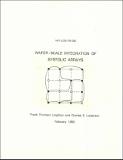Browsing Computer Science and Artificial Intelligence Lab (CSAIL) by Title
Now showing items 3740-3759 of 3804
-
Visual Recognition and Categorization on the Basis of Similarities to Multiple Class Prototypes
(1997-09-01)To recognize a previously seen object, the visual system must overcome the variability in the object's appearance caused by factors such as illumination and pose. Developments in computer vision suggest that it may be ... -
Visual Routines
(1983-06-01)This paper examines the processing of visual information beyond the creation of the early representations. A fundamental requirement at this level is the capacity to establish visually abstract shape properties and ... -
Visual Segmentation without Classification in a Model of the Primary Visual Cortex
(1997-08-01)Stimuli outside classical receptive fields significantly influence the neurons' activities in primary visual cortex. We propose that such contextual influences are used to segment regions by detecting the breakdown of ... -
Visual Speech Synthesis by Morphing Visemes
(1999-05-01)We present MikeTalk, a text-to-audiovisual speech synthesizer which converts input text into an audiovisual speech stream. MikeTalk is built using visemes, which are a small set of images spanning a large range of mouth ... -
Visual Tracking
(1992-10-01)A typical robot vision scenario might involve a vehicle moving with an unknown 3D motion (translation and rotation) while taking intensity images of an arbitrary environment. This paper describes the theory and implementation ... -
Visual Tracking of Real World Objects
(MIT Artificial Intelligence Laboratory, 1975-07)This paper describes the progress made towards tracking an object visually using a PIN diode attached to a dual mirror deflection system which enables the PIN diode to "optically point" to any position in two-space. A ... -
Vote the OS off your Core
(2011-07-27)Recent trends in OS research have shown evidence that there are performance benefits to running OS services on different cores than the user applications that rely on them. We quantitatively evaluate this claim in terms ... -
Wafer-scale Integration of Systolic Arrays
(1983-02)VLSI technologists are fast developing wafer-scale integration. Rather than partitioning a silicon wafer into chips as is usually done, the idea behind wafer-scale integration is to assemble an entire system (or network ... -
Wait-and-See Strategies for Parsing Natural Language
(MIT Artificial Intelligence Laboratory, 1974-08)The intent of this paper is to convey one idea central to the structure of a natural language parser currently under development, the notion of wait-and-see strategies. This notion will hopefully allow the recognition of ... -
Wait-free Regular Storage from Byzantine Components
(2005-04-05)We present a simple, efficient, and self-contained construction of a wait-free regular register from Byzantine storage components. Our construction utilizes a novel building block, called 1-regular register, which can be ... -
Waiting Algorithms for Synchornization in Large-scale Multiprocessors
(1991-02)Through analysis and experiments, this paper investigates two-phase waiting algorithms to minimize the cost of waiting for synchronization in large-scale multiprocessors. In a two-phase algorithm, a thread first waits by ... -
Walter User's Manual (Version 1.0)
(1987-09)Walter is a UNIX program that provides access to databases located at MIT via the DARPA Internet. The databases provided by Walter include the full-text of the New York Times for the past 90 days. A sophisticated full-text ... -
Wandering About the Top of the Robot
(MIT Artificial Intelligence Laboratory, 1971-07)Part I of this paper describes some of the new functions in the system. The discussion is seasoned here and there with parenthetical code fragments that may be ignored by readers unfamiliar with PLANNER. Part II discussed ... -
Was the Patient Cured? Understanding Semantic Categories and Their Relationships in Patient Records
(2006-06-28)In this thesis, we detail an approach to extracting key information in medical discharge summaries. Starting with a narrative patient report, we first identify and remove information that compromises privacy (de-identifi ... -
WaveScript: A Case-Study in Applying a Distributed Stream-Processing Language
(2008-01-31)Applications that combine live data streams with embedded, parallel,and distributed processing are becoming more commonplace. WaveScriptis a domain-specific language that brings high-level, type-safe,garbage-collected ... -
Weak Consistency: A Generalized Theory and Optimistic Implementations for Distributed Transactions
(1999-03)Current commercial databases allow application programmers to trade off consistency for performance. However, existing definitions of weak consistency levels are either imprecise or they disallow efficient implementation ... -
Weak Monadic Second Order Theory of Successor is not Element-recurive
(1973-12)Let L SIS be the set of formulas expressible in a week monadic second order logic using only the predicates [x =y+1] and [x E z]. Bucci and Elgot [3,4] have shown that the truth of sentences in L SIS (under the standard ... -
Werner Reichardt: the man and his scientific legacy
(2011-03-04)Excerpts from a talk given by Tomaso Poggio in Tübingen on the opening ofthe Werner Reichardt Centrun für Integrative Neurowissenschaften, December 8, 2008. -
Whanaungatanga: Sybil-proof routing with social networks
(2009-09-24)Decentralized systems, such as distributed hash tables, are subject to the Sybil attack, in which an adversary creates many false identities to increase its influence. This paper proposes a routing protocol for a distributed ... -
What a Parallel Programming Language Has to Let You Say
(1984-09-01)We have implemented in simulation a prototype language for the Connection Machine called CL1. CL1 is an extrapolation of serial machine programming language technology: in CL1 one programs the individual processors ...



















